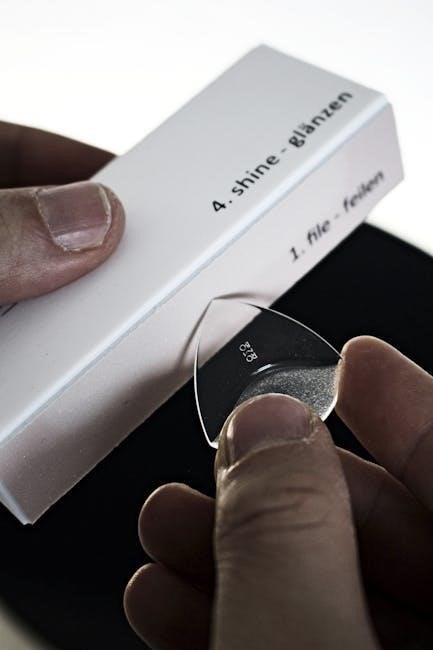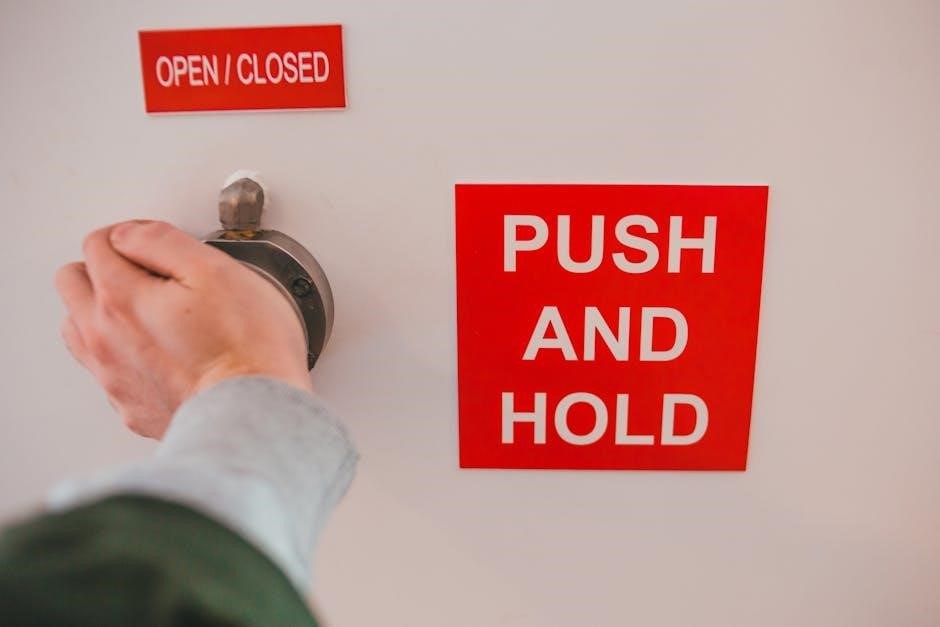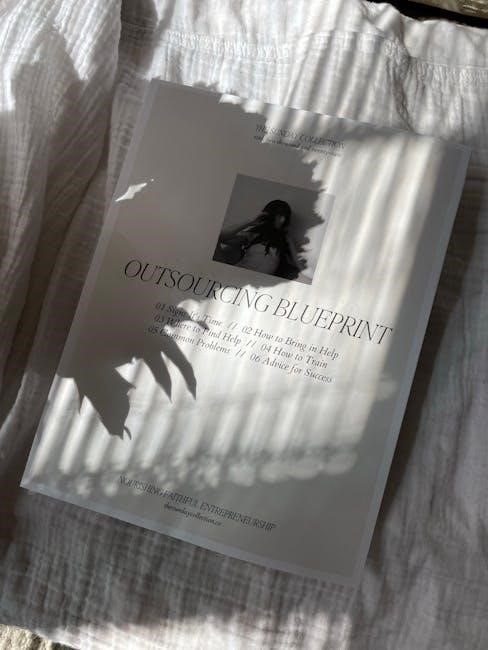
Safety Precautions and Warnings
READ ALL INSTRUCTIONS BEFORE USE. Inspect crib for damage, loose joints, or missing parts. DO NOT USE if any issues are found. Regular checks ensure safety.
1.1. General Safety Guidelines
READ ALL INSTRUCTIONS carefully before assembling or using the crib. Inspect the crib for damage, loose joints, or missing parts before and after assembly. DO NOT USE the crib if any components are damaged or missing. Regularly check for wear and tear. Ensure the mattress fits snugly, meeting the specified size and thickness requirements. Avoid using harsh cleaning products, as they may damage the finish. Always follow the manufacturer’s instructions for cleaning and maintenance. KEEP THE INSTRUCTIONS for future reference. Adult assembly is required, and small parts may pose a choking hazard for children.
1.2. Warning Labels and Symbols
Warning labels and symbols are provided to ensure safe use of the crib. These labels highlight critical safety information, such as weight limits, proper assembly, and usage guidelines. Always locate and read these labels before starting assembly. Symbols may indicate prohibited actions, like using incorrect mattresses or placing the crib near windows. Pay attention to warnings about loose joints, damaged hardware, or missing parts, as these can pose serious safety risks. Failure to follow these warnings may result in injury or death. Refer to the manual for explanations of all symbols and labels. Ensure all warnings are understood and followed carefully to guarantee the crib’s safe operation. Ignoring these labels can compromise your child’s safety.
1.3. Compliance with Safety Standards
The 4-in-1 crib is designed to meet or exceed ASTM and JPMA safety standards, ensuring durability and safety for your child. It is rigorously tested for structural integrity, material quality, and hazard prevention. The crib complies with federal regulations for baby furniture, including mattress fit, rail height, and toxicity standards. Regular inspections are required to maintain compliance. Always follow the manufacturer’s guidelines to ensure the crib remains safe and functional. Non-compliance due to improper assembly or unauthorized modifications voids the warranty. Adherence to these standards guarantees a secure environment for your child. Proper use as outlined in the manual is essential for maintaining compliance and ensuring your child’s safety.

Product Overview and Features
The 4-in-1 Crib offers versatility, converting from crib to toddler bed, daybed, and full-size bed. Its durable design and lifetime warranty ensure lasting value and reliability.
2.1. Key Features of the 4-in-1 Crib
The 4-in-1 Crib is designed for long-lasting use, adapting to your child’s growth. It converts seamlessly from a crib to a toddler bed, daybed, and full-size bed, ensuring years of functionality. The crib features an adjustable mattress height setting, providing convenience as your child grows. Made from high-quality, durable materials, it offers a sturdy and safe sleeping environment. The crib is JPMA certified, meeting rigorous safety standards for peace of mind. Additional features include a sleek, timeless design and easy-to-follow assembly instructions; The toddler bed conversion kit is often included, making transitions smooth and hassle-free. This versatile crib is a practical and stylish choice for any nursery.

2.2. Benefits of a Convertible Crib
A convertible crib offers numerous benefits, providing long-term value and convenience. Its ability to transition from a crib to a toddler bed, daybed, and full-size bed ensures it grows with your child, eliminating the need for multiple purchases. This adaptability saves money and space while maintaining a consistent, stylish design in the nursery. The conversion process is typically straightforward, requiring minimal additional hardware; Additionally, convertible cribs are eco-friendly, reducing the need for frequent furniture replacements. They also provide peace of mind, as they meet rigorous safety standards for each stage of use. This versatility makes a 4-in-1 crib a practical and timeless investment for families.
2.3. Included Components and Accessories
The 4-in-1 crib typically includes a crib frame, mattress support, and conversion hardware for transitioning to a toddler bed, daybed, or full-size bed. Additional components may vary by model but often include a toddler bed rail for safety during the conversion phase. Some cribs come with a storage drawer or shelves for added convenience. The package usually contains Allen-key bolts, cylindrical fasteners, and other necessary hardware for assembly and conversion. A mattress is typically sold separately, with specific size and thickness requirements. Always ensure all parts are included and undamaged before assembly. Optional accessories, such as bed rails or decorative trim, may be available for purchase separately.

Assembly Instructions
Follow the step-by-step guide in the manual to assemble the crib. Use the provided tools to secure all parts tightly. Ensure all hardware is properly aligned and fitted.
3.1. Preparing for Assembly
Before starting, carefully read all instructions to understand the process. Ensure all components are included and undamaged. Lay out all parts and hardware on a clean, flat surface. Organize tools like Allen wrenches and screwdrivers as specified in the manual. Double-check for any missing or damaged items. Inspect the crib frame for sharp edges or defects. Clean the area to avoid clutter and ensure safe assembly. Familiarize yourself with the assembly sequence to avoid confusion. If unsure, gather a second person to assist. Keep small parts out of reach of children to prevent choking hazards. Ensure proper lighting and a stable workspace. Begin only when fully prepared to ensure a smooth and safe assembly experience.
3.2. Step-by-Step Assembly Guide
Begin by carefully unpacking all components and verifying the inclusion of all hardware and instructions. Start with the base of the crib and attach the legs using the provided bolts. Ensure they are securely tightened. Next, assemble the crib frame by aligning the sides and back panel with the base. Use the Allen wrench to secure these parts with the included screws. Attach the mattress support platform, ensuring it is level and evenly positioned. Install the railings and side panels, making sure all connections are tight. Double-check that all bolts and screws are fully tightened. Once the crib is fully assembled, place the mattress inside and ensure it fits snugly without gaps. Finally, inspect the crib for stability and proper assembly before use.
3.3. Tips for First-Time Assemblers
For first-time assemblers, start by laying out all components and hardware in a clear workspace. Read the instructions thoroughly before beginning. Use the Allen wrench provided, as other tools may damage the bolts. Work methodically, following each step in order. If unsure, take your time and double-check alignment; Organize small parts in a container to avoid misplacement. Place the crib on a firm, flat surface during assembly to ensure stability. Avoid over-tightening bolts initially; snug them and finish with a final tightening round. Refer to the diagram for visual guidance. Finally, inspect the crib for stability and proper assembly before use.

Conversion Instructions
Follow step-by-step guides for converting the crib to a toddler bed, daybed, or full-size bed. Use the provided Allen wrench and refer to diagrams for clarity.
4.1. Converting to a Toddler Bed
To convert the crib to a toddler bed, remove the front rail and lower the mattress to its lowest position. Use the provided Allen wrench to detach the front panel. Ensure all bolts are securely tightened after conversion. Place the toddler bed rail (if included) to prevent falls. Double-check for loose joints or parts before allowing your child to use the bed. Keep the mattress firm and fitted to avoid gaps. Regularly inspect the bed for stability and safety. Follow the manual’s diagrams for accurate conversion steps.
4.2. Converting to a Daybed
To convert the crib to a daybed, follow these steps: Remove the front rail and lower the mattress to its lowest position. Use the Allen wrench to detach the front panel bolts. Place the side rails in their outward position to form the daybed frame. Ensure all hardware is securely tightened. Position the mattress snugly within the frame to avoid gaps. Double-check for stability and loose joints before use. The daybed configuration allows for a comfortable resting place while maintaining the crib’s structural integrity. Always refer to the manual for specific bolt locations and tightening instructions. Regular inspections are crucial to ensure safety and durability.
4.3. Converting to a Full-Size Bed
To convert the crib to a full-size bed, begin by detaching the toddler rail and removing the front and back panels. Lower the mattress to its lowest position and attach the full-size bed frame rails. Use the provided Allen wrench to secure the bolts tightly. Ensure the side support legs are firmly attached to the bed frame for stability. Place the full-size mattress (as per manufacturer specifications) snugly within the frame. Double-check all hardware for tightness and alignment. Regularly inspect the bed for loose joints or wear. Follow the manufacturer’s instructions precisely to ensure a safe and sturdy conversion. Always prioritize safety and stability when transitioning to a full-size bed configuration.

Mattress Specifications and Requirements
The mattress must be at least 37-3/4 inches long, 23-3/4 inches wide, and no more than 2 inches thick. Use only the mattress provided by the manufacturer.
5.1. Recommended Mattress Size and Thickness
The mattress must meet specific size and thickness requirements to ensure proper fit and safety. It should be at least 37-3/4 inches long and 23-3/4 inches wide, with a maximum thickness of 2 inches. Using a mattress that exceeds these dimensions or is too thick can compromise the crib’s safety features. Always use the mattress provided by the manufacturer or one that meets these exact specifications. A proper fit prevents gaps between the mattress and crib sides, reducing the risk of entrapment or suffocation. Check the manual for precise measurements, as slight variations may exist between models. For optimal support and safety, adhere strictly to these guidelines.
5.2. Mattress Material and Firmness Guidelines
The mattress must be made of firm, breathable material to ensure your baby’s safety and comfort. Avoid using soft bedding, pillows, or thick padding, as these can pose suffocation risks. Opt for a standard firm foam mattress specifically designed for cribs. Memory foam mattresses are not recommended due to their softness. The mattress should fit snugly within the crib, with no gaps between the mattress and the crib sides. Always check for recalls and ensure the mattress meets current safety standards. For optimal support, choose a mattress with a tight-fitting cover and avoid any additional padding unless specified in the manual. Regularly inspect the mattress for signs of wear or damage.
5.3; Approved Mattress Types for the Crib

Only use mattresses specifically designed for cribs and approved by the manufacturer. The mattress must be firm and fit snugly within the crib to prevent gaps. Avoid using mattresses with soft or sagging surfaces, as they can pose a suffocation risk. Innerspring or foam mattresses are recommended, provided they meet current safety standards. Mattresses with breathable materials, such as organic cotton or ventilated foam, are ideal for temperature regulation. Ensure the mattress is designed for a crib of this size and does not exceed the recommended thickness of 2 inches. Never use makeshift or improvised bedding, as it may not meet safety requirements. Always check for certifications from organizations like the Consumer Product Safety Commission (CPSC).

Maintenance and Upkeep
Regularly inspect the crib for damage or wear. Clean with a soft cloth and mild detergent, avoiding harsh chemicals. Check hardware for tightness and functionality. Store disassembled parts securely when not in use.
6.1. Cleaning and Sanitizing the Crib
To maintain the crib’s condition, clean it regularly using a soft cloth and mild detergent. Avoid harsh chemicals or abrasive cleaners, as they may damage the finish. For tough stains, gently spot clean with a damp cloth. Do not use window cleaners or abrasive products, as they can scratch the surface. Allow the crib to air dry completely before reuse. Regular sanitizing helps prevent germs and maintains hygiene. Always follow the manufacturer’s recommendations for cleaning products. Ensure all parts are dry to prevent moisture damage. Cleaning regularly will help keep the crib safe and functional for years to come.
6.2. Checking and Tightening Hardware
Regularly inspect the crib’s hardware for loose joints, damaged parts, or missing components. Use an Allen wrench (if provided) to tighten any loose bolts or screws. Turn the crib on its side to access hard-to-reach areas. Check all connections, including mattress support brackets and frame links. Tighten firmly but avoid over-tightening, which may strip screws. For first-time assemblers, ensure all parts are securely locked in place. If any hardware feels unstable, disassemble and reassemble the section carefully. Loose parts can cause the crib to wobble, posing a safety risk. Perform these checks periodically to maintain the crib’s stability and ensure your child’s safety. Always refer to the manual for specific tightening instructions.

Troubleshooting Common Issues
Common issues include loose joints or wobbly parts. Check hardware regularly and tighten as needed. Address scratches or damage promptly to ensure safety and stability.
7.1. Addressing Loose Joints or Wobbly Parts
Loose joints or wobbly parts can compromise the crib’s stability. Inspect all connections regularly, especially after moving or converting the crib. Tighten any loose bolts or screws using the Allen wrench provided. If a part is damaged or missing, disassemble the crib and replace the component. Avoid using the crib until repairs are made. For persistent issues, refer to the troubleshooting section in the manual or contact customer support. Regular maintenance ensures the crib remains safe and sturdy for your child. Always follow the manufacturer’s guidelines for repairs to avoid further damage or safety risks. If unsure, consult the warranty information for potential replacements or professional assistance.
7.2. Fixing Scratches or Damaged Finishes
For minor scratches or damaged finishes on the crib, clean the area with a soft cloth and mild detergent. Avoid using abrasive cleaners or harsh chemicals, as they may damage the protective coating. Lightly sand the area with fine-grit sandpaper to smooth out rough edges. Apply a furniture wax or polish specifically designed for cribs to restore the finish. For deeper scratches, use a touch-up paint provided by the manufacturer or a matching wood stain. Allow the area to dry completely before using the crib. Regularly inspect the crib’s finish for wear and tear to prevent further damage. Always follow the manufacturer’s guidelines for repair products to ensure safety and maintain the crib’s warranty.

Product Warranty and Support
The crib is backed by a manufacturer’s warranty covering defects in materials and workmanship. Register your product for warranty activation. Contact customer service for assistance or repairs. Keep the manual for warranty details and terms.
8.1. Understanding the Manufacturer’s Warranty
The manufacturer offers a warranty covering defects in materials and workmanship for a specified period. This warranty applies to the original purchaser and is non-transferable. Coverage includes repairs or replacements for defective parts, excluding normal wear and tear. To validate the warranty, ensure the crib is assembled and used as per the instructions. Registration may be required to activate the warranty. Exclusions include damage caused by misuse, improper assembly, or modification of the product. For warranty claims, contact customer service with proof of purchase and a detailed description of the issue. Keep the manual and purchase receipt for reference. Regular inspections and proper maintenance ensure warranty compliance.
8.2. Contacting Customer Service for Assistance
For any questions or concerns regarding your 4-in-1 crib, contact our customer service team. Representatives are available to assist with warranty claims, assembly issues, or general inquiries. You can reach us via phone at 1-800-CRIB-CARE or email at support@cribmanufacturers.com. Include your product serial number, purchase date, and a detailed description of the issue for faster resolution. Visit our website at www.cribhelp.com for additional resources or to submit a support request online. Our team is committed to providing timely and effective assistance to ensure your satisfaction.